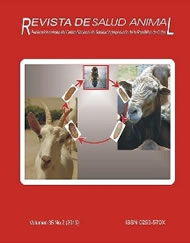Territorial risks analysis by transboundary animal diseases in Cuba
Contenido principal del artículo
Resumen
A methodology for the territorial risk analysis of biological disasters due to transboundary animal diseases (TADs) was developed and conducted in all municipalities in the country. The methodology identifies the relevant places for the potential entry and the following spreading of TADs (objectives with biological risk-OBR), and characterizes the level of their vulnerability (sanitary gaps) as well as that of the local animal populations. The vulnerability of animal populations considers many topics divided into four aspects: structure of animal production, sanitary control, urbanization of animal rearing, and general characteristics of the municipality. In 161 municipalities, 1597 OBRs were identified. Few municipalities were classified at the highest level of risk but sanitary breaches were identified in many of them. The identification of sanitary breaches and the General Index of Biological Risk in each municipality and OBR was usefull for the improvement of
the disaster risk reduction plan. The communication of the biological risk is better understood and accepted by the stakeholders through this process. The use of the methodology for developing plans for prevention diseases at local level is discussed.
the disaster risk reduction plan. The communication of the biological risk is better understood and accepted by the stakeholders through this process. The use of the methodology for developing plans for prevention diseases at local level is discussed.
Detalles del artículo
Cómo citar
1.
Percedo MI, González I, Chávez P, Delgado C, Abeledo MA. Territorial risks analysis by transboundary animal diseases in Cuba. Rev. Salud Anim. [Internet]. 3 de septiembre de 2013 [citado 18 de noviembre de 2025];35(2):116. Disponible en: https://revistas.censa.edu.cu/index.php/RSA/article/view/217
Número
Sección
ARTÍCULOS ORIGINALES
Aquellos autores/as que tengan publicaciones con esta revista, aceptan los términos siguientes:
- Los autores/as conservarán sus derechos de autor y garantizarán a la revista el derecho de primera publicación de su obra, el cual estará simultáneamente sujeto a la Licencia Creative Commons Attribution-NonCommercial 4.0 International (CC BY-NC 4.0) que prohíbe el uso comercial de sus publicaciones y permite a terceros compartir la obra siempre que se indique su autor y la primera publicación en esta revista. Bajo esta licencia el autor será libre de:
- Compartir — copiar y redistribuir el material en cualquier medio o formato
- Adaptar — remezclar, transformar y crear a partir del material
- El licenciador no puede revocar estas libertades mientras cumpla con los términos de la licencia
Bajo las siguientes condiciones:
- Reconocimiento — Debe reconocer adecuadamente la autoría, proporcionar un enlace a la licencia e indicar si se han realizado cambios. Puede hacerlo de cualquier manera razonable, pero no de una manera que sugiera que tiene el apoyo del licenciador o lo recibe por el uso que hace.
- NoComercial — No puede utilizar el material para una finalidad comercial.
- No hay restricciones adicionales — No puede aplicar términos legales o medidas tecnológicas que legalmente restrinjan realizar aquello que la licencia permite.
- Los autores/as podrán adoptar otros acuerdos de licencia no exclusiva de distribución de la versión de la obra publicada (p. ej.: depositarla en un archivo telemático institucional o publicarla en un volumen monográfico) siempre que se indique la publicación inicial en esta revista.
- Se permite y recomienda a los autores/as difundir su obra a través de Internet (p. ej.: en archivos telemáticos institucionales o en su página web) antes y durante el proceso de envío, lo cual puede producir intercambios interesantes y aumentar las citas de la obra publicada. (Véase El efecto del acceso abierto).
